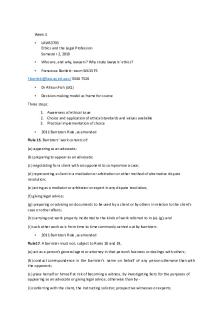SAR - Lecture notes Summary PDF

| Title | SAR - Lecture notes Summary |
|---|---|
| Author | Camilla Iker |
| Course | Cell & Developmental Biology |
| Institution | Baylor University |
| Pages | 2 |
| File Size | 46.1 KB |
| File Type | |
| Total Downloads | 56 |
| Total Views | 133 |
Summary
Summary...
Description
SAR o Very diverse o DNA similarities o Controversial o Groups: Stramenophiles V imp 2ndry endosym from red algae Hairy and smooth flagellum pair Organisms: o Diatoms Unicell Component phytoplank Two part wall of SiO2 Holes release pressure Fossilized diatoms=diatomaceous earth Blooms use CO2, pump C to bottom of ocean Good for env o Golden algae Yellow and brown cartenoids Biflagellate Most unicellular Mixotrophic Phagocytic Phytoplank of freshwater Cysts in hostile conditions o Brown algae (phaeophytes) Largest, most complex Multicellular Marine; temperate cool waters Fucoxanthin (xanthophyll) gives color Structure Holdfast ~ root Stipe ~ stem Blade ~ leaf Floats keep blades close to sunlight No true tissues or organs Imp to humans Life cycles: alternation of generations o Multicell gametophyte (n) alt w multicell sporophyte (2n) o Isomorphic: structurally same o Heteromorphic: structurally dif Alveolates Alveoli: sm memb bound cavity under PM Func: stability, water/ion reg 2ndry symbiosis of red algae Orgs: o Dinoflagellates: flagellates Cellulose plates 2 flagella
Phytoplankton (marine and freshwater) Foundation aquatic FC Mixotrophic Some heterotrophs Bioluminescence Mutualistic symbionts: Coral polyps, sea anemone, jellyfish, radiolarians, foraminiferans Blooms= red tide Some prod toxins, can kill orgs o Apicomplexans: parasites Endoparasites Spread as sporozites Apex: contains complex of organelles to penetrate tissues Apicoplasts: non photosynthetic plastid from red algae Sex and asex stages: 2+ hosts Plasmodium= malaria Mosquito & human= host Can change surface protein; evade detection o Ciliates: predators Predator of bac and other protists 2 types nuclei: Macronuclei (2n) “everyday genes” Micronuclei (n) Paramecium Shuffle genes in conjugation o Sex process o Exchange haploid micronuclei o Inc genetic variability o No repod no ofspring o Micronuclei fuse diploid micronucleus; meiosis Asex by binary fission o Macronuc disintegrates o 2n macronuc forms new ones by mitosis o 2 rounds binary fission4 daughter cells...
Similar Free PDFs

SAR - Lecture notes Summary
- 2 Pages

SBTE-SAR - Penicillins
- 3 Pages

CHEM3123 Lecture Summary Notes
- 31 Pages

Summary of lecture notes
- 4 Pages

Lecture notes, summary
- 2 Pages

Summary Learning Lecture notes
- 15 Pages

Final SAR Report
- 11 Pages

PROSEDUR DARURAT DAN SAR
- 84 Pages
Popular Institutions
- Tinajero National High School - Annex
- Politeknik Caltex Riau
- Yokohama City University
- SGT University
- University of Al-Qadisiyah
- Divine Word College of Vigan
- Techniek College Rotterdam
- Universidade de Santiago
- Universiti Teknologi MARA Cawangan Johor Kampus Pasir Gudang
- Poltekkes Kemenkes Yogyakarta
- Baguio City National High School
- Colegio san marcos
- preparatoria uno
- Centro de Bachillerato Tecnológico Industrial y de Servicios No. 107
- Dalian Maritime University
- Quang Trung Secondary School
- Colegio Tecnológico en Informática
- Corporación Regional de Educación Superior
- Grupo CEDVA
- Dar Al Uloom University
- Centro de Estudios Preuniversitarios de la Universidad Nacional de Ingeniería
- 上智大学
- Aakash International School, Nuna Majara
- San Felipe Neri Catholic School
- Kang Chiao International School - New Taipei City
- Misamis Occidental National High School
- Institución Educativa Escuela Normal Juan Ladrilleros
- Kolehiyo ng Pantukan
- Batanes State College
- Instituto Continental
- Sekolah Menengah Kejuruan Kesehatan Kaltara (Tarakan)
- Colegio de La Inmaculada Concepcion - Cebu







